
I love working with all-purpose flour. It’s so cheap and easy to buy huge bags from my local Walmart or Smith’s or Costco. Then, I dump the flour into my fifty-pound plastic storage container. Whenever I feel like baking, I just roll out my flour container and scoop out whatever I need.
But some bread recipes call for strong flour or bread flour. Bread flour tends to be more expensive than all-purpose flour, especially if I choose well-known brands over store brands.
Since I’m more of a hobbyist, amateur baker, I’d rather not spend more money than necessary. On several occasions, I’ve asked myself “do I really need bread flour for baking bread? Why bother?”
So I decided to do a little research on how to turn All-purpose flour into bread flour and the difference it makes in my baking.
What’s the Difference?
At first glance, all-purpose flour and bread flour seem similar. They’re both flour. They’re both great for making bread. They both taste almost the same.
However, mills grind and sift all-purpose flour from hard winter wheat. Bread flour, in contrast, comes from hard spring wheat, which has a higher protein content than winter wheat.
In general, bread flour has about 12 -14% protein while all-purpose only checks in between 8-11%. Now that protein percentage might not seem like a lot, but it does make a difference in baking.
Wheat protein contains wheat gluten, the stringy strands that give your bread its texture, elasticity, and structure. The more gluten your bread has, the better your bread will rise and hold its shape when baking. Additionally, gluten gives your bread its characteristic chew.
| What’s the Difference? | All-Purpose Flour | Bread Flour |
| Protein Content | 8-11% | 12-14% |
| Gluten Strength | Moderate, Soft Gluten Network | Strong, Elastic Gluten Network |
| Bake Texture | Soft, Tender | Chewier, Better Rise |
| Best For | Cakes, Cookies, Pancakes, and Muffins | Sandwich Bread, Artisan Sourdough Loaves, Pizza Dough, Bagels |
| Can You Substitute? | Yes, With Adjustments | Yes, But Results Vary |
So if you want to turn all-purpose flour into bread flour, you’re going to need to bump up the gluten content with vital wheat gluten.
What’s Vital Wheat Gluten?
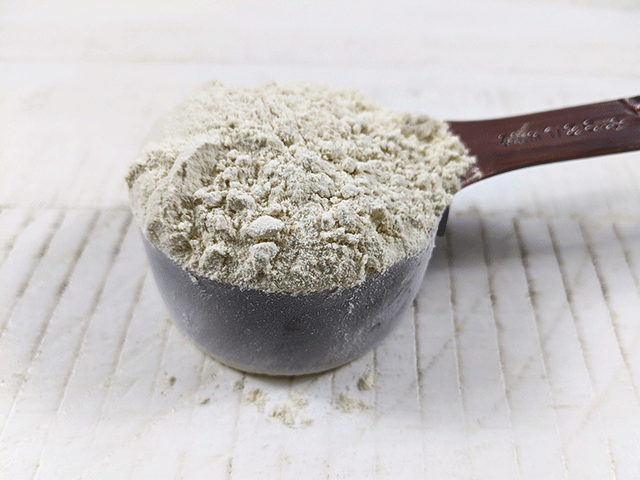
Vital wheat gluten comes from wheat flour. The wheat flour is hydrated to activate the gluten, and then the gluten itself is extracted, dried, and ground into a powder.
Because it’s pure gluten, you don’t need a lot to have a big impact in your baking. When you combine it with low-protein flours, like all-purpose flour, it bumps up the protein percentage for chewier, more shapely breads.
But you don’t need to stop at low-protein flours. You can also add it to any bread recipe that might need a little extra support and structure, such as recipes with a lot of fruit, seeds, or nuts. Feel free to also for making seitan, a vegetarian-friendly alternative to meat.
You can buy vital wheat gluten at your local grocery store, often in the baking section, though occasionally it pops up near gluten-free sections (and the irony makes me laugh a little). Walmart does carry it, as well as Whole Foods, and nutritional supplement stores such as The Vitamin Shoppe.
If you can’t find it in stores, you can buy Vital Wheat Gluten on Amazon.com for about $15 for a 4-pound bag (though that price is subject to change). I do earn a small commission for Amazon purchases as an Amazon associate, but don’t feel obligated to buy your gluten from the above affiliate link.
Here’s How Much to Add
Lots of baking sites disagree about how to turn all-purpose flour into bread flour. Some people recommend adding just 1 teaspoon of vital wheat gluten per cup of all-purpose, while others recommend 1 to 3 tablespoons per recipe.
I guess the variation depends on the baker’s preferences and budget. And since you can technically add vital wheat gluten to bread flours and bump the already-high protein content even higher, it depends on what you’re looking for in the consistency of your bread.
If you truly love baking bread, you can just experiment with different amounts of wheat gluten to see how it changes your bread. Take notes of what you like and dislike, then go from there.
However, for the amateur baker like myself, I need something a little more consistent. A few websites agree that 1 1/2 teaspoons per cup gets good results, so that’s what I’ll recommend, too.
Here’s What You’ll Need to turn All-Purpose Flour into Bread Flour
Grab your measuring cups, spoons, or digital scale and:
- 115 Grams (1 Cup minus 1 1/2 Teaspoons) All-Purpose Flour
- 5 Grams (1 1/2 Teaspoons) Vital Wheat Gluten
Then whisk them together. That’s it! Super easy.
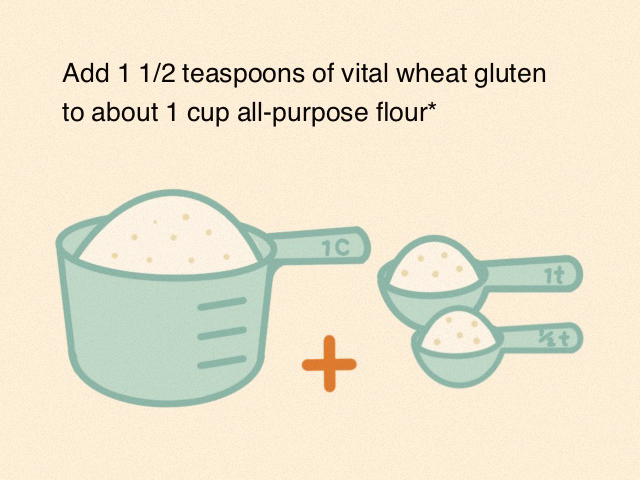
Here’s the Formula for Your Next Recipe
Don’t want to measure all-purpose flour cup by cup to make bread flour substitute? You can do a little bit of math at the beginning of your recipe, if you measure by weight.
- Total Bread Flour Needed in Grams * 0.95 = All Purpose Flour
- Total Bread Flour – All Purpose Flour = Gluten
Or to be more precise:
- X(0.95) = Y
- X – Y = Z
Example
If your recipe needs 500 Grams Bread Flour, you’d do the following math:
500 Grams Bread Flour Needed * 0.95 = 475 Grams All-Purpose Flour
500 Grams Bread Flour Needed – 475 All-Purpose Flour =25 Grams Vital Wheat Gluten

Seems a little confusing? Don’t worry – if I try a recipe with bread flour substitute, I’ll do the math for you and provide the measurements for turning all-purpose flour into bread flour.
Do You Save Money?
This is where things get a little tricky. Prices for all-purpose flour and bread flour vary widely from store to store, and sales can make either flour more affordable than the other.
However, if I use Amazon.com and compare a few popular brands, I can do some math and give you a guess.
The Cost of King Arthur Flour
Currently, here’s what each flour type costs:
- King Arthur Unbleached All-Purpose Flour: $10.50 for a 5 lb. bag = $0.13 an ounce
- King Arthur Unbleached Bread Flour: $7.29 for a 5 lb. bag = $0.09 an ounce
In this case, bread flour is actually cheaper per ounce than all-purpose flour. If you make bread a lot, this isn’t a bad deal.
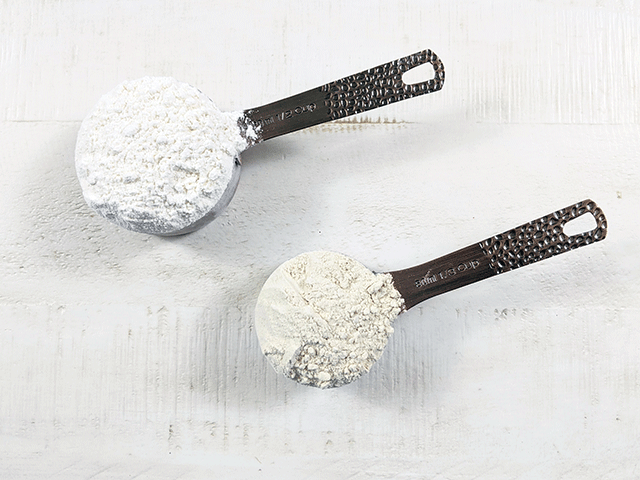
What About White Lily Flour?
But let’s take a look at another brand:
- White Lily All-Purpose Flour: $16.51 for two 5 lb. bags = $0.10 an ounce
- White Lily Bread Flour: $11.99 for a 5 lb. bag = $0.15 an ounce
In this case, the bread flour is much more expensive. Let’s see what the price would be if we added Vital Wheat Gluten to the all-purpose flour. For this hypothetical, I chose Anthony’s Vital Wheat Gluten at $14.59 for a 4 lb. bag at $0.23 an ounce.
If we use the same formula from above, 5 grams vital wheat gluten and 125 grams all-purpose flour make 1 cup bread flour substitute. A 4 lb. bag of vital wheat gluten has 1814.37 grams, so it could make potentially 362 when combined with 343 cups (41, 160 grams or 90 pounds) all-purpose flour.
Continuing down that path, 90 pounds of White Lily All Purpose Flour would cost $148.59 plus the cost of vital wheat gluten at $14.59 would amount to $163.18 to make a total of 362 cups of bread flour substitute.
Assuming my math is correct here, 362 cups of bread flour would weigh approximately 43,440 (at 120 grams in a cup), or about 1532 ounces. And your total would be about $0.10 per ounce.
Phew! That’s a lot of math here.
Your Savings
In the White Lily flour example, turning all-purpose flour into bread flour with the vital wheat gluten would ultimately save you money. And it could potentially save a lot of space in your kitchen, if you keep a small bag of vital wheat gluten on hand and mix it with your all-purpose flour as you go. You wouldn’t have to buy 90 pounds of flour all at once to reap the savings.
Furthermore, having vital wheat gluten on hand would also allow you to experiment in your baking, which would make the investment worth it, too.
What’s a Good Price for Flour?
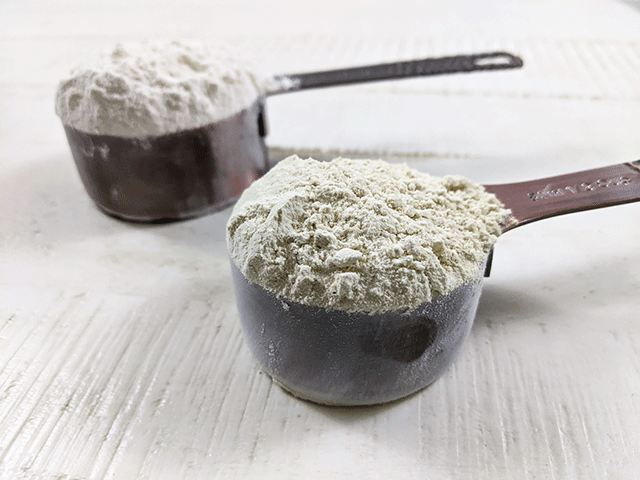
That’s the magical question isn’t it.
For amateur bakers who want to save money, I’ve seen Walmart sell large 25 lb. bags of all-purpose flour for about $5.18, or as little as $0.02 an ounce. I buy that flour all the time and use it for many of my recipes. It gets the job done.
However, that doesn’t necessarily mean the flour is amazing quality. Serious bakers tend to opt for well-known brands such as Arrowhead Mills, Gold Medal, and White Lily. These brands can range anywhere from $0.05 an ounce to as much as $0.20 an ounce.
As a rule of thumb, I’d say try to find all-purpose flour that costs less than $0.10 an ounce and bread flour for less than $0.15 an ounce.
Whenever possible, buy flour as part of a bulk sale to get an even lower price. Then buy a bag of vital wheat gluten to have on hand so you can turn all-purpose flour into bread flour whenever it’s convenient.
I know pandemics tend to make flour more difficult to find at times, so just keep an eye out for good deals whenever you can find them and then stock up.
Did You Try It?
I know that I did a lot of math in this post, so forgive me if I made an error along the way (and please point out any mistakes so I can fix them). But I find that doing the math lets me see where I can save money and whether that bread flour sale I see on sale is worth it.
Let me know if you tried turning all-purpose flour into bread flour at home! Did you prefer to measure by weight or by volume? Did you like the difference it made in your bread’s consistency or not? Share your thoughts in the comments below!

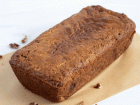


Very interesting, it’s cheaper for me to continue purchasing King Arthur AP Flour $3.16 for 5lbs & King Arthur Bread Flour $3.29 for 5lbs. If you have a Walmart buy it there. I can’t imagine paying that kind of price for any brand of flour. I know some people must. It’s a shame that Amazon has such prices on some things. Thank you so much! Happy Baking.
Thank you so much Bea! I really appreciate your comment 🙂 Assuming I did my math right, you’re only paying $0.03 an ounce for flour and that’s a great deal! That’s good to know that you’ve got great prices on all purpose flour and bread flour at your local Walmart.
Actually no, your math is incorrect. One 5 gram is one teaspoon, not 1 1/2 teaspoon (and it’s always 15g to the tablespoon, and two tablespoons to the ounce). Doesn’t matter if it’s flour or beach sand. Measured correctly you will be using 1/3 more Vital Wheat Gluten than you estimated. In my area AP four is $2.43 and Bread flour is $3.93, so two cups of bread flour is $0.44. Adding VWG (at $8.99 for 20 oz) to AP flour (at $0.27 per 2 cup loaf) = $0.51 per loaf of bread. Just plain less expensive to use bread flour unless you can live with 1 tsp of VWG per cup of flour, in which case the final cost is the same for bread flour off the shelf. That works for me most of the time, except when baking with Rye flour.
Hey Alese, thanks for your input on the math. Generally speaking, yes, 1 teaspoon is 5 grams – but that applies to water which has a 100% packing efficiency. However, your assumption that it “doesn’t matter if it’s flour or beach sand” isn’t always true. Ingredients do have different weights even if they measure the same volume. I always do a quick search for each ingredient I list to find the most common conversion of volume to weight. Thank you for letting me know about the cost of all purpose flour in your area and that the final cost for you is less expensive. It is interesting to see how prices vary from place to place.
Jenni was so kind on her response.
Just to confirm her answer, everything has different densities. 1 teaspoon of Ethiopian coffee ground up will weigh different than Guatemalan coffee ground up. Different salts weigh differently than each other due to their density in there mineral compound to water weight. Weigh a tablespoon of sugar and then a tablespoon of flour… they’ll weigh differently. 🙂
Very confidently incorrect here Alese. You can’t just equate a teaspoon (a 5ml measure of volume) with 5g (a measure of weight). For anything (like water) where 1ml = 1g, then it works, but when the density is different (as it is with flour) then you need to be working with weights and not volume measures.
Frankly everything in baking should be done in weights and not volume measures.
I ran out of AP flour
Needed to make lemon bars
Have a lot of bread flour and can I
Sub the bread flour for the AP flour so I will not have to run to the store
Thanks
Go ahead and make those lemon bars! You can substitute bread flour for all-purpose anytime – it just has a higher protein percentage than all-purpose so your bars will have a chewier texture but it shouldn’t affect the flavor at all.
I didn’t have bread flour so used all purpose AND the bread has a good rise and texture. Ill make it again.
Awesome. I’m glad you had a positive baking experience 🙂
The kicker for me is I don’t have a partial bag of bread flour hanging about forever(since I can’t remember when it was purchased). I can’t think flour approaching 2years old can be at it’s best.
You’re right that flour doesn’t stay fresh forever. Refined flours like all-purpose have a low fat content so they last a while before spoiling, as long as two years if stored properly. Bread flours have a higher fat content, so they’ll fall short of that mark by a few months. You can tell if flour has gone rancid if it smells musty or sour or if it looks discolored. Definitely toss your old bread flour bag if it has mold or bugs in it.
For me I always freeze my flour AP or Bread flour. They keep longer even if expired. I also add a bay leaf & branch in it to store them. Old wives tale “ bay leaf “ rids of bugs. Not only that it helps it also gives an aroma. I do the same to my rice as well. All of my cupboards always have bay leaves scattered around it. Under the sink as well just in case????
That’s an excellent tip! Thank you so much.
I have been using vital wheat gluten to make bread flour for years. This the first time I have seen the actual measurements. Thank you.
You are so welcome! I’m glad it helped you.
So far king arthur bread flour has not let me down. I tried using local stop & shop all purpose flour with vital wheat gluten ad a substitute for bread flour and the results were disastrous. 6 failed recipes. It may be that the A.P.F. sold has overestimated its protein content.
Darn. I’m sorry that you’ve had such bad luck with all purpose flour. I’m glad that King Arthur Bread flour has been a reliable brand for you so far!
Thank you for sharing the formula.
Am I missing something, though?
“500 Grams Bread Flour Needed * 0.95 = 480 Grams All-Purpose Flour”
When I multiply is, I get 475 g of AP flour.
Anne – thank you so much for correcting me. It looks like 480/500 = 0.96. I think it was just a small typo on my end, and that in turn messed up my math. I’ll fix that really quick.
I appreciate your math especially with the gluten flour. . I found when it comes to flour that there is a difference from one brand to another in protein percentage even in all purpose flour. It’s easily searchable. You could make your adjustments based off that. I started adding gluten flour to my fresh ground wheat flour decades ago. Its a tricky thing to get a loaf that isn’t too dense so I add the gluten flour. Now I use it and dough enhancer and some all purpose
Those are very good points. Thank you so much!
If I don’t have the wheat to add to my all purpose flour, can I just use all purpose flour instead without adding ingredients to make bread flour
Hey Stephanie, bread flour has a higher protein content than all-purpose. Without vital wheat gluten, your all-purpose flour won’t have the same texture and chew as bread flour. However, lots of bread recipes bake and taste just fine with ordinary all-purpose. If you’re making a regular sandwich bread or quick bread, the difference is almost negligible. Artisan loaves benefit the most from bread flour because they need more gluten to hold their shape.
This is a great tip. Where I live the Costco Organic AP flour is half the cost of King Arthur, with the same percentage of protein. So, this vs. purchasing good quality bread flour will save me money. Plus, I like the idea of not having to have two different flours on hand. Will give it a try.
and for every 475 g flour and 25 g gluten how much water must be added
Hey Shiva, how much water you add depends entirely on what you’re making. Rolls, buns, bread? Different breads require different amounts of water, so just check whatever recipe you’re using at the time.
I think the big saving comes when you’re using organic flours. Organic bread flour can be +75%-100% the cost of Organic All-Purpose flour. Adding some VWG to Organic All Purpose is still much cheaper than buying the organic bread flour.
Excellent point. Thank you!
This great thank you so much! I’m tired of having to store so many different flours! When I was growing up we just had flour. All my mom’s baking was the best. She used gold medal. I recently went back to gold medal as I had several bags of King Arthur all purpose that had bugs. Some dead and some alive. I can’t stop seeing them yuck. I sift everything now. In King Arthur I will even find Brown something ? I have since sifted everything in my kitchen. I’m an avid baker so this takes time. But I have never found anything at all in gold medal. I will still sift just in case. But so far so good. This is a great help I appreciate so much. Thank you !
Thanks for letting me know about your experience with different flours! I appreciate your comment
I’m not being rude, but… Can these measurements just be in tps, tbsp, cups or oz? I get so frustrated with the grams part, can never figure these out, which makes me not want to try recipes with grams. It takes more time trying to figure these out in other measurements when converting and defeats the purpose! I have yet to even make bread. Three times I’ve tried, following to a tee, and still get a hard rock of a dough. Is it better to sift when measuring? I’d like to find a simple bread recipe that is not so complicated! Help a newbie baker out! 😝
Hey Sylvie – you’re not bring rude at all. I totally understand the frustration, which is why all my recipes have both grams and cups listed for your convenience. In general, it’s always better to weigh ingredients for accuracy as cups can vary in sizes, sometimes by as much as several tablespoons between brands! I have lots of recipes for beginning bakers – just check out the navigation bar and look at difficulty, beginner. Hope this helps!
You should splurge and spend the ten bucks to buy a kitchen scale! I put it off for so long but I’m so glad I finally just got the scale. Cooking feels so much more legit, and fun, when I pull out my little scale. 🙂
It worked great for my rasin-cranberry loaf! Thanks a ton JenniBee!
You are so welcome! I’m happy it worked for you. Thank you for sharing.
What if no VWG is available locally and to get by post it cost the earth.
Hey Joe, I hear you. Vital wheat gluten can be expensive. While I recommend using it to make bread flour, I have also baked plenty of loaves with regular all purpose flour just fine without it. Or you can by bread flour on its own if it is cheaper than ordering vital wheat gluten. With a little bit of math, you can decide what works best for you and your situation. Happy baking!
I was wondering, does vital wheat gluten go bad?
Hey penny, yes vital wheat gluten can go bad. When opened, it can stay fresh for about 6-12 months depending on how it’s stored. If unopened it can last for years.